The occurrence of remote work was accelerated by the pandemic and will permanently affect the way organizations utilize office space. This leaves office users and investors wondering how to respond. We will assess the risks and benefits of remote work and the changing role of the physical workplace in a three-part blog series that discusses:
- The evolution of office trends from the 1950s to today,
- Research insights on the impacts of remote work and the disturbing undercurrents that employers should pay attention to as they transition to post-pandemic norms,
- And a guide to assist organizations and investors transform their commercial offices into thriving spaces that earn people’s commute.
In part one, we look at the evolution of office trends to see how current events and technology have shaped the workplace and employee preferences over time.
The 1950s: The Golden Age of American Capitalism
In the earliest days of Rock n’ Roll and “I Love Lucy,” work was just that – work. While families moved to the suburbs in homes decorated in light pastels, the workplace remained purely functional and bland. General employees worked on an open floor lined with desks, like a paper factory assembly line. Unlike today, these open plans did not encourage collaboration. Instead, the hope was that lack of privacy would lead to greater productivity. Executives typically had private offices with the most senior workers taking the best window views.
Photo of Forsyth County Courthouse Office, 1956
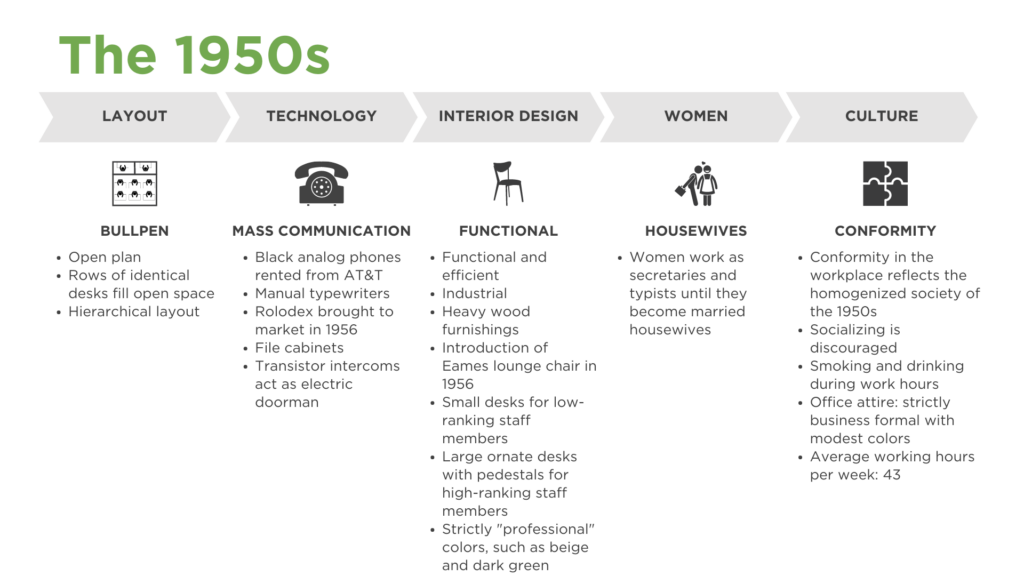
The 1960s: A Decade of Revolution & Social Change
The Sixties saw transformational changes in society, which ultimately invited more color and personality into the workplace. The “bullpen” layout remained standard until Herman Miller furniture company launched the Action Office in 1964. The Action Office was a three-walled, hinged space designed to promote movement, privacy, and flexibility. This layout included “communication centers” for collaborative work. A collaborative environment was encouraged over hierarchy and status. Herman Miller argued that office work was mental work and better done in environments that provide privacy and fewer distractions. The U.S. Treasury allowed businesses to write off office equipment for tax purposes, encouraging business owners to invest in equipment, like the Action Office, over construction.
Photo of Winston-Salem State College office employees, 1968
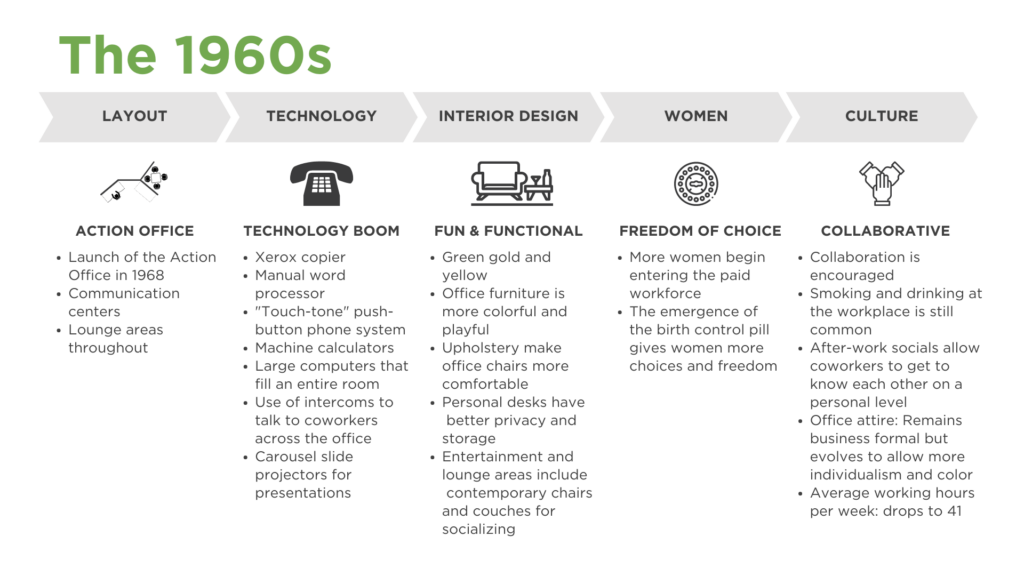
The 1970s: The ‘Me’ Decade
The Seventies were a time of individuation in America. This new way of thinking seeped into offices through colorful interior decorating. The post-war economic boom reinvigorated American workers with self-determination. Through motivation and self-development, employees worked up the tangible hierarchy of the office to compete for desk locations. The Action Office was pricey, so companies copied the concept with cubicles. The debate over open plans, cubicles, and private offices began with cubicles ultimately prevailing in this era. Organizations accepted the importance of minimizing distractions, which led to the popularity of the less-noisy electric typewriter. Mimicking the health and fitness movement of the nation, organizations added new ergonomic office chairs to demonstrate their commitment to wellness within the workplace.
Photo of employee in computer room at Bowman Gray School of Medicine, 1970
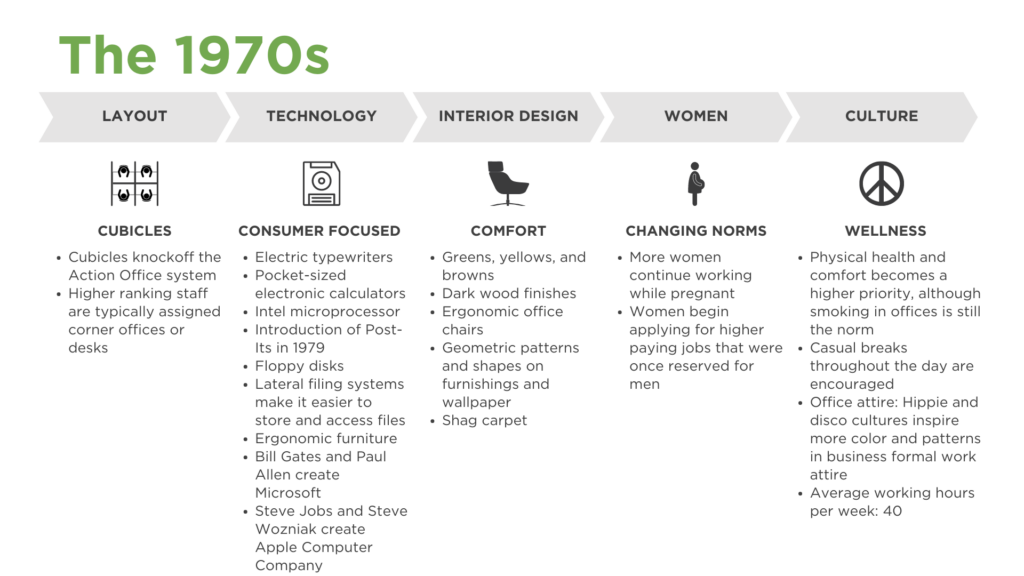
The 1980s: The Decade of Greed
The idea of “corporate culture” spawned, inspiring a new office aesthetic with clean lines. Materials like chrome, glass, and concrete were popular. The office’s personality was reserved for the publicly visible reception areas. This included garish designs, like bold graphics and bright colors, popular in the 1980s. Cubicles remained but shrank in size to fit the growing employment rate. In contrast to the reception areas, the cubicle spaces lacked character. This office environment contributed to the resentment towards large corporations as this layout tangibly reflected their “profits before people” mentality.
Personal computers (PCs) and fax machines entered the scene and began a technological era that change the workplace forever. Most offices had fewer PCs than employees, so PCs lived in shared workspaces. Businessman and writer Alvin Toffler boldly predicted that offices would soon be irrelevant due to the advancements in telecommuting.
Photo of Forsyth County librarian conducting an online information retrieval search, 1985
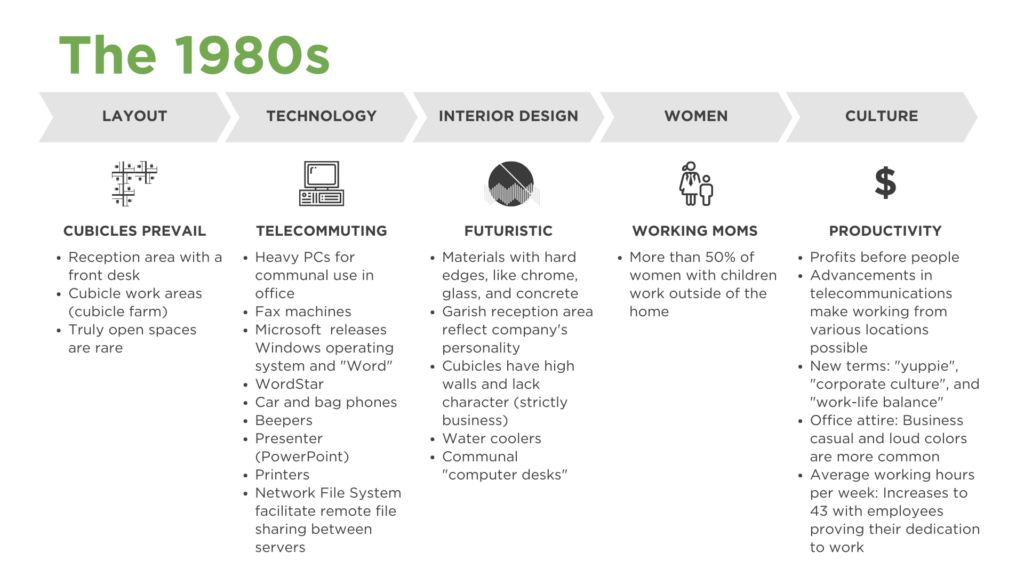
The 1990s: The Good Decade
While the World Wide Web fundamentally changed how the world operated, office design stagnated. Cubicles were more boring and beige than ever. The “U-shape” suites debuted with a bridge work-surface between the back credenza and front desk (yawn). Offices adopted mundane cultures to match the aesthetics, bringing us comedies like “Office Space” and “The Office.”
In some ways, office culture reflected a tone similar to that of the 1950s. Employees lost trust in corporations, which reflected the nation’s growing skepticism towards government entities. Even still, the Nineties were a golden era. Dramatic cultural transformations were occurring with the emergence of a new pop culture. The U.S. saw a budget surplus for the first time in 30 years. The booming economy led to a 10% increase in wages, and employees became willing to trade salaries and benefits for flexibility and autonomy.
Photo of Apple computer workstation, 1990
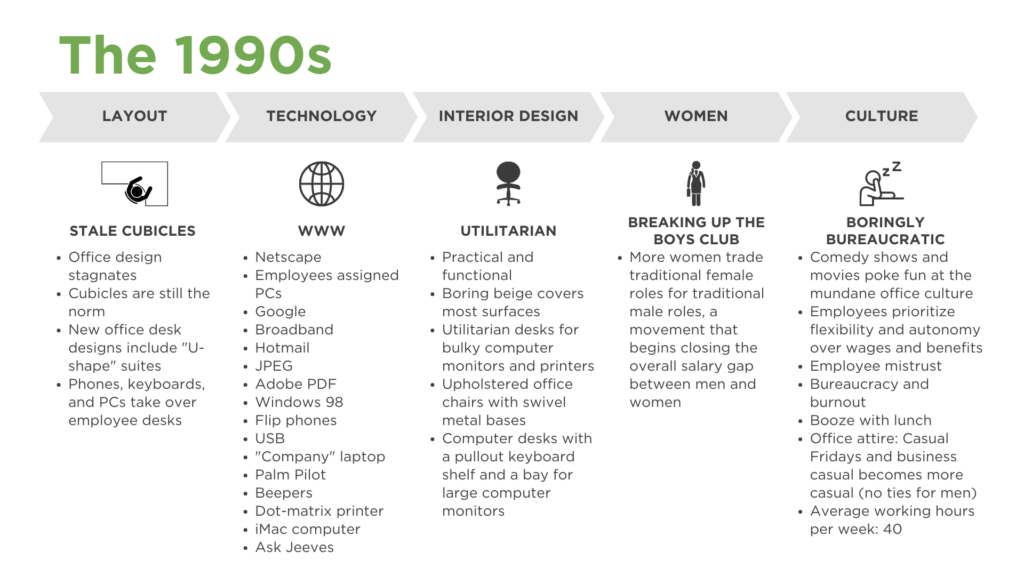
The 2000s: The iDecade
The idea of success in the workplace shifted as millennials entered the workforce. Organizations bucked the bland culture and became more unconventional, informal, and youth-focused. Successful young tech entrepreneurs set the trends, and encouraged a culture of innovation, hustle, and teamwork. Companies like Google modeled fun office designs that other organizations imitated. Workers were untethered from cubicles with spacious open layouts for team collaboration. In some offices, “hot-desking” was preferred over assigned desks. Email was a new smartphone function, which changed the way employees interacted with each other. Although iPhones came out in 2007, Blackberry dominated the business world.
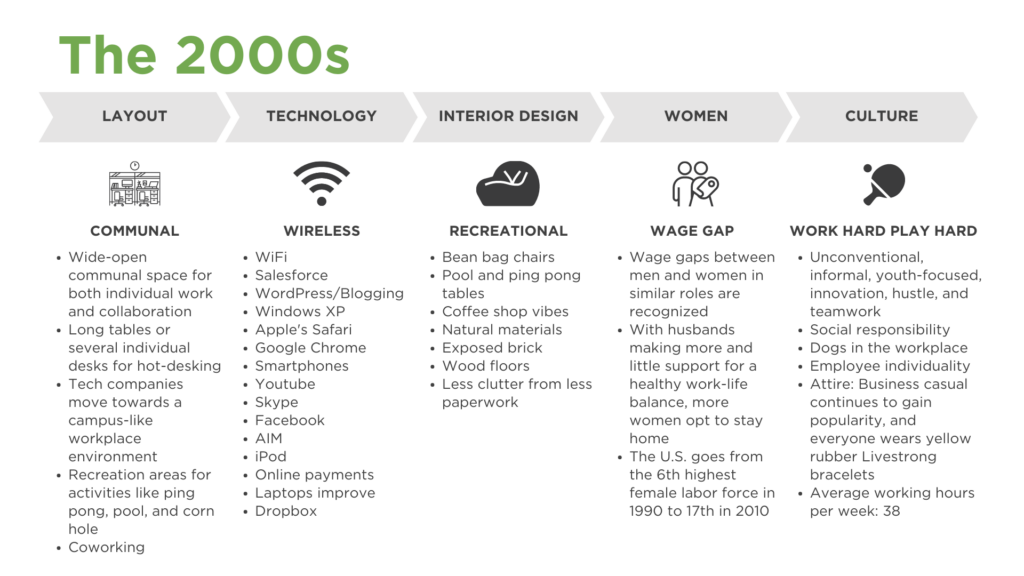
The 2010s: The Already Forgotten Decade
The 2000s and 2010s blur together in many ways, including office trends. That’s not to say that everything was the same. There were technology advancements, but these were mostly improvements to existing products. Collaboration, community, and equality defined ideal office cultures.
Millennials were well entrenched in the workforce with many starting families. This brought back the trend of suburban living and commuting to work seen in the 1950s. The freelance workforce grew 8.1% between 2014 and 2018, which led to the popularity of remote work and coworking spaces. During this era, companies acknowledged the negative impacts of high turnover on their bottom line, leading to an increased focus on company culture for better employee recruitment, engagement, and retention.
Large corporations continued to push the boundaries of office design by incorporating sustainability into design plans. Open offices where CEOs worked with general employees sparked discussions on how organizations integrate. By this point, many began to wonder if these wide-open offices posed too many distractions. Are these open spaces encouraging collaboration if every employee wears Airpods to block distractions? The pandemic would soon bring answers to this dilemma.
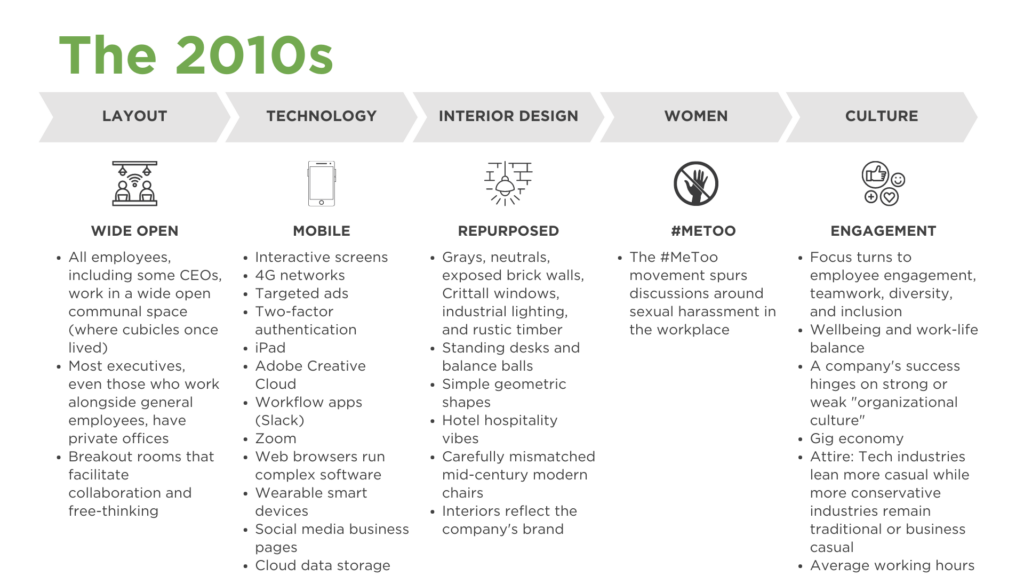
Conclusion & Takeaways:
An obvious trend in office layouts is that they tend to move from one extreme to another, for example, openness versus privacy and keeping things strictly business versus incorporating social activities. What would happen if organizations could create a balanced space for different kinds of work activities?
As history shows, allowing the culture to form naturally without intentionality puts the organization in danger of taking on the nation’s culture at the time, both positively and negatively. Workplace culture should be intentional. Remote work is more common now, so how does an organization cultivate a culture under these circumstances? Should organizations allow people to make individual choices regarding where and how they work, even if it negatively impacts trust and goes against the organizational culture?
Next week, we will seek to answer these pressing questions in part two of our three-part blog series on the post-pandemic workplace. Subscribe to our blog to receive notifications for new posts on commercial real estate in the Piedmont Triad!
More Office Space Articles:
- Trends in Office Upfit Construction
- The Impact of Office Space & Layout on Company Culture
- What Your Office Design Says About You
- Why Company Culture Matters in Real Estate (and Every Industry)
- Why Leasing Strategy Is More Than Just Signing the Deal
- Cap Rates, Co-Tenancy, and Contingencies: A Real Estate Glossary for Operators
- Understanding Rule 506(c): What It Means for Real Estate Investors
- How to Evaluate a Real Estate Investment Opportunity Like a Pro